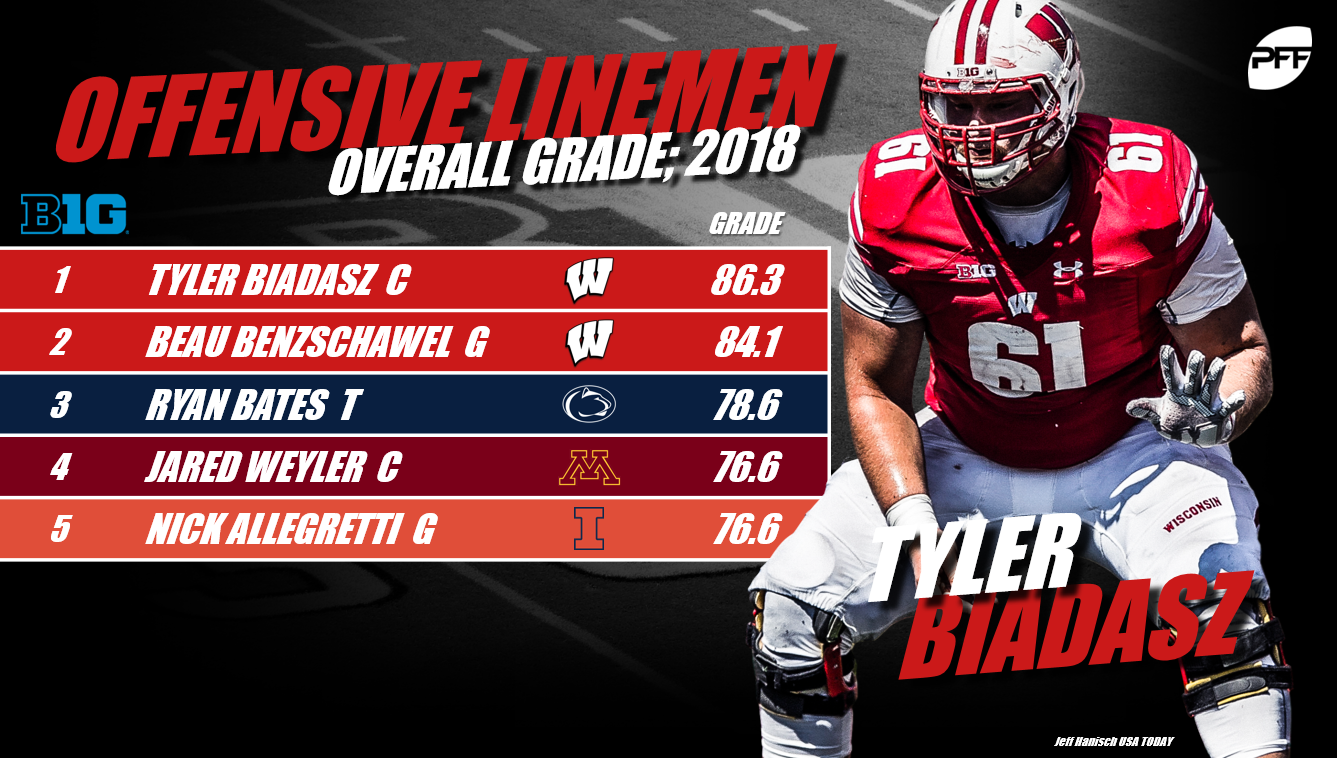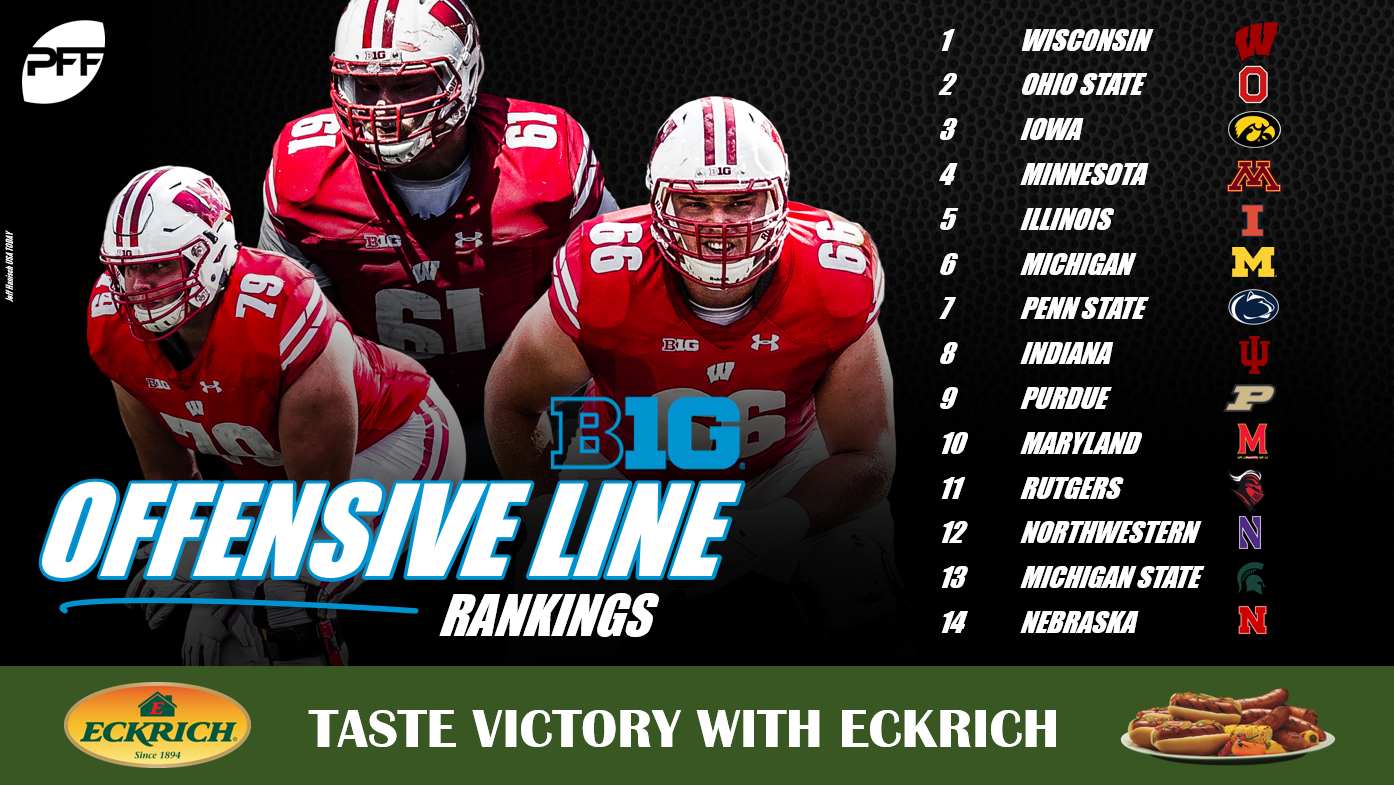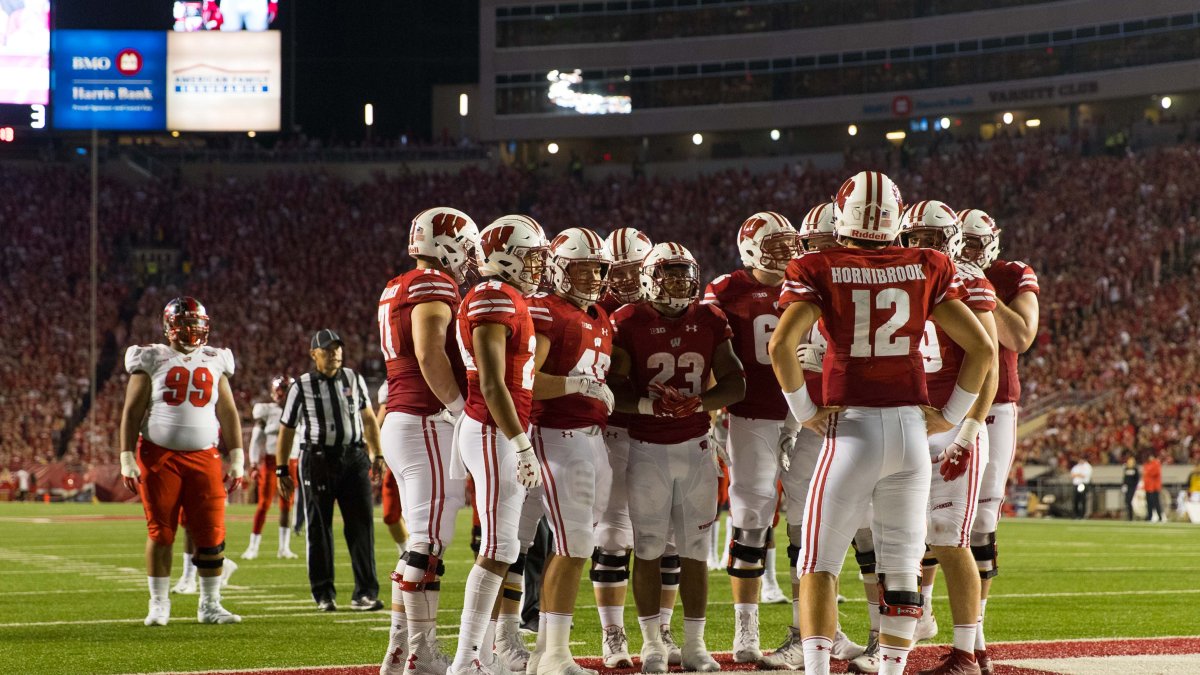Heading into the season, the Big Ten had arguably the best offensive line on paper as Wisconsin had several players represented on our College Top 50 from their offensive line. After five weeks of action, that continues to ring true in the conference as the Badgers unit paces the Big Ten as the best offensive line through Week 5.
Diving into the PFF database to look at grades over the first five weeks while also focusing on how players and teams have performed so far this season, we’re able to rank every line in the conference, from first to 14th. This has been done using both our PFF grades and also our pass-blocking efficiency signature stat, allowing us to form a clearer overall picture of performance.
The Big Ten OLine Rankings are brought to you by Eckrich, the Official Smoked Sausage of the College Football Playoff.
1. Wisconsin Badgers
Wisconsin leads the Big Ten in PFF pass-blocking and run-blocking grades, are the only team in the conference with PFF grades of 80.0 or above for both and have a team run-blocking grade 6.8 points higher than the next best offensive line. Simply put, they have the best line in the conference, and it’s not really that close. In center Tyler Biadasz (86.3) and right guard Beau Benzschawel (84.1), they have the two highest-graded starters on the offensive line in the conference, with the pair combining to allow just six pressures so far this season.

2. Ohio State Buckeyes
The Buckeyes are another team who have impressed both in pass protection and in the running game, with PFF grades of 76.3 and 76.6, respectively. All five of their starters have produced grades of 66.8 and above with center Michael Jordan (75.0), right tackle Isaiah Prince (71.1) and right guard Demetrius Knox (70.6) their top three players on the line. With 28 pressures allowed from 199 pass-blocking snaps so far this season, they rank third in the conference with a pass-blocking efficiency rating of 92.7.
3. Iowa Hawkeyes
If we were only looking at their work in pass protection, Iowa would be pushing Wisconsin for the top spot in these rankings, such has been their success at slowing down opposing pass-rushers. From 117 passing plays, they have allowed just three sacks, one hit and seven hurries, giving them a conference-leading 94.0 pass-blocking efficiency rating. Left tackle Alaric Jackson has been the star, allowing just one hurry from 87 pass-blocking snaps but all five starters have produced pass-blocking grades of 74.4 or higher. The issue is that they haven’t had the same success as run-blockers, with 374 of their 590 rushing yards from running backs coming after contact.
4. Minnesota Golden Gophers
The Golden Gophers have been solid both as pass-blockers and run-blockers, with PFF grades of 74.4 and 71.1, respectively. With 22 total pressures allowed from 127 pass-blocking snaps, their 89.8 pass-blocking efficiency ranks seventh in the conference as center Jared Weyler has yet to allow a sack, hit or hurry all season. Every starter on the offensive line has produced a PFF run-blocking grade of 60.0 or higher and right tackle Sam Schlueter is the only starter with a pass-blocking grade lower than 75.0. They might not be quite as dominant as the three teams above them but they have been pretty solid across the board so far in 2018.
5. Illinois Fighting Illini
Despite struggling in pass protection, where both their PFF grade of 70.1 and their pass-blocking efficiency rating of 86.0 ranks last in the conference, Illinois are buoyed by their work in the running game. Four of their five starters on the offensive line have produced PFF run-blocking grades of 69.0 or higher and their team grade of 77.0 ranks second in the conference. So far this season, their running backs are averaging 4.02 yards per carry before contact, highlighting their success in this regard.
6. Michigan Wolverines
Michigan ranks second in the conference with a pass-blocking efficiency rating of 92.9, having allowed just 19 total pressures from 148 pass-blocking snaps so far this season. They have found much more success as pass-blockers than run-blockers in 2018, with guards Michael Onwenu and Ben Bredeson, and right tackle Juwann Bushell-Beatty producing PFF pass-blocking grades of 80.0 or higher. Onwenu has been their best pass-blocker and has yet to allow a sack, hit or hurry this season. Their issue has been in the running game as just two starters hold a PFF run-blocking grade above 60.0, and their running backs see an average of just 2.4 yards before contact per carry.
7. Penn State Nittany Lions
Penn State’s grade profile is very similar to Michigan’s as they've produced a PFF run-blocking grade of 61.7 while Michigan just edges them with a pass-blocking grade of 78.6 compared to their 78.2. Left tackle Ryan Bates leads the team in pass-blocking grade (79.8) and run-blocking grade (74.7), having allowed just two sacks, a hit and five hurries from 182 pass-blocking snaps. Like Michigan, they have struggled to generate much room for their running backs, averaging just 1.6 yards before contact per carry.

8. Indiana Hoosiers
With four sacks, 13 hits and 26 hurries allowed from 201 pass-blocking snaps, Indiana’s pass-blocking efficiency rating of 88.3 ranks eighth in the Big Ten this season, which is exactly where they come in here in our conference offensive line rankings. They are the very definition of a middle-of-the-pack offensive line, with four of the six players on the line to play at least 200 snaps producing a PFF pass-blocking grade of 70.0 and above, but just three with run-blocking grades of 60.0 or above. Left tackle Coy Cronk has been their best player in both pass protection and run-blocking, allowing a sack, three hits and five hurries so far this season.
9. Purdue Boilermakers
It hasn’t been great for the Boilermakers running game so far this season, with the offensive line giving their running backs an average of 2.3 yards before contact. They have fared slightly better as pass-blockers though, ranking ninth in the conference with a pass-blocking efficiency rating of 88.1, having surrendered four sacks, nine hits and 34 hurries from 215 pass-blocking snaps. Four of their five starters on the offensive line have produced PFF pass-blocking grades of 70.0 or higher with Matt McCann allowing just one sack, two hits and four hurries from his time at both right guard and right tackle this season.
10. Maryland Terrapins
Maryland ranks fourth in the conference with a pass-blocking efficiency of 91.4, but their style of offense plays a part in that as their pass-blocking grade of 75.8 ranking eighth in the conference. It is as run-blockers where they have really struggled, with their team grade of 59.5 the third worst in the Big Ten, and just one offensive lineman who has played at least 200 snaps producing a run-blocking grade above 65.0.
11. Rutgers Scarlet Knights
Rutgers is tied for the second-lowest pass-blocking grade in the conference through the first five weeks of the season and rank 10th with a pass-blocking efficiency of 87.7, having allowed five sacks, 11 hits and 23 hurries so far. Both starting tackles have allowed double-digit pressures as left tackle Tariq Cole has allowed two sacks, five hits and seven hurries, and right tackle Kamaal Seymour has allowed two sacks, a hit and eight hurries. The good news is that based on what we’ve seen over his career so far, this should just be a blip for Cole, who produced PFF grades of 82.0 and 76.3 in 2016 and 2017, respectively.
12. Northwestern Wildcats
Right tackle Rashawn Slater has been the standout on the Wildcats offensive line, producing a PFF grade of 73.9 and allowing no sacks this season. The unit as a whole has struggled in pass protection though, surrendering the most total pressures (49) in the conference, and producing the second-lowest pass-blocking efficiency at 86.1 to go along with a PFF pass-blocking grade of 72.3 which is tied for the second-lowest mark in the Big Ten.
13. Michigan State Spartans
Michigan State has actually been solid in pass protection, ranking seventh in the conference in pass-blocking grade at 75.8, and fifth in pass-blocking efficiency rating at 91.3, having allowed five sacks, three hits and 12 hurries so far this season. The same cannot be said of their work in the running game though. They have created just 1.8 yards before contact for their running backs, and a team run-blocking grade of 48.8 which ranks last in the conference.
14. Nebraska Cornhuskers
Like Michigan State, Nebraska has given their running backs an average of just 1.8 yards before contact per carry, and with a team grade of 49.6, they rank second to last in the conference next to the Spartans. They have also struggled in pass protection, ranking 10th in PFF pass-blocking grade. The lack of a standout player also hurts them, with no player on the offensive line producing a PFF grade of 65.0 or higher so far this season.



 © 2025 PFF - all rights reserved.
© 2025 PFF - all rights reserved.